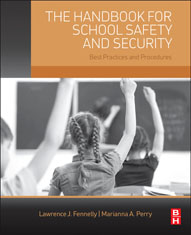Author: Edited by Lawrence Fennelly and Marianna Perry
ISBN No: 9780 12800 5682
Review date: 02/05/2024
No of pages: 420
Publisher: Butterworth-Heinemann, Elsevier
Publisher URL:
www.elsevier.com
Year of publication: 03/09/2014
Brief:
Handbook for School Safety and Security: Best Practices and Procedures
This insightful and challenging American book shows how risky schools in the States can be, given that the authors have to write about emergency response and guns and knives. They do not shy away from quoting real tragedies such as Columbine, Virginia Tech and Sandy Hook.
The book argues that after such shootings, it turns out that the survivors tell of odd behaviour by the shooter. The killer may have had mental health issues, or had been bullied or cyber-bullied. Or, a jilted lover or fired employee may feel wronged. Violence may be a student reaction to bullying. The book advocates CPTED (crime prevention through environmental design), what they term ‘an all-hazards approach’, to assess risks from shootings and terrorism to flood or fire or power outage. On crime – which may be petty such as theft from desks or dormitories – the book suggests that ‘most places have no crime and most crime is highly concentrated and in a relatively small number of places. If we can prevent crime at these high crime places, then we might be able to reduce total crime’.
A most intriguing chapter is ‘crime risk versus feeling safe in schools: true and false risk’. When (if ever) asked, children say that they feel safe in school, as at home. That the Dutch chapter author Paul van Soomeren suggests is only natural. You tend not to feel afraid of what places you are used to. But that is not the same as saying you’re free of crime, or that you feel safe walking to and from school in the dark. Being young does bring risk of theft and violence. A book quoted early on is The Gift of Fear by the American Gavin de Becker, interviewed in our June and July 2014 issues by Una Riley.
While the book does well to point out that children and teenagers are different – they are not fully formed like adults, though adults we know can behave irrationally and plain stupidly, through drink for instance. In schools, the adult staff are in loco parentis. There’s a duty of care, which however applies in any business. Hence much of the advice can apply to any workplace: you define and prepare for the threat,
This book then tells you how to prepare for when something goes drastically wrong: you run-hide-fight (three options as set out by the US federal Department of Homeland Security). Run is always your first option; your response is based on how near you are to the threat, and where you are. If you don’t have barriers between you and the ‘active shooter’, and you cannot lock the intruder out, you evacuate at a run. If not, you can decide whether to barricade yourself in, or lock-down, or if you cannot run, you fight, though the authorities do not recommend training students in fighting. They do recommend training in running and hiding. Interestingly the official advice is that run-hide-right is for each person to act on, not as a whole school or building.
As a North American book, it goes through US laws and rules, but it’s worthwhile reading for anyone in school and university campus protection. More broadly, the book has some pithy sections that anyone in security can read with profit, such as the ‘100 things you need to know about school security’ over 30 pages at the end. Turn also to chapter seven which usefully confronts and knocks down some myths and wishful thinking – such as, armed guards (Columbine had an armed security officer in the school at the time of the mass shooting) or an incident reporting system are enough to cover you. Security management – such as, an ounce of prevention is worth a pound of cure – applies to student safety also.
The Handbook for School Safety and Security: Best Practices and Procedures, edited by Lawrence Fennelly and Marianna Perry. Published 2014 by Butterworth-Heinemann, Elsevier, 420 pages, ISBN 9780 12800 5682. visit www.elsevier.com. Online price £27.74.










